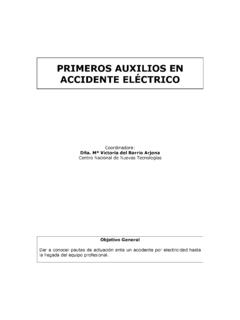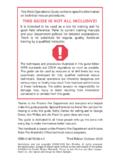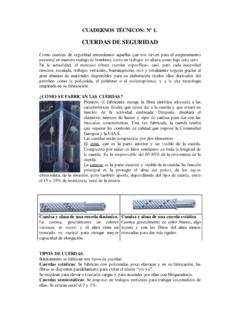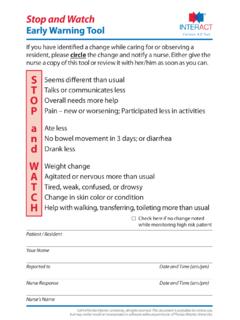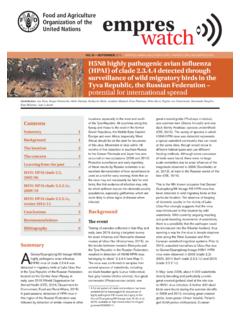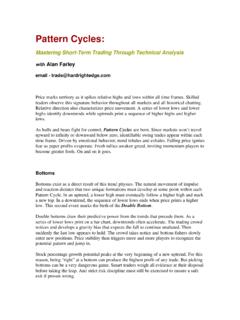Transcription of on technical rescue procedures. THIS GUIDE IS NOT ALL ...
1 this Field Operations GUIDE contains specific informationon technical rescue procedures . this GUIDE IS NOT ALL INCLUSIVE!It is intended to be used as a tool for training and forquick field reference. Refer to current training manualsand your department policies for detailed is no substitute for regular, quality, hands-ontraining by a qualified techniques and procedures illustrated in this GUIDE followNFPA standards and OSHA regulations as much as GUIDE can be used by rescuers at all skill levels but wasspecifically developed for fully qualified technical rescuetechnicians. Special operations are inherently dangerous andserious injury or fatality may result from improper performanceof these techniques. The author accepts no responsibility fordamage, loss, injury or death resulting from informationcontained in or omitted from this to the Phoenix Fire Department and everyone who helpedmake this GUIDE possible.
2 Special thanks to my friend Ron Jamison forhelping to write this GUIDE , Kathy Darrow for editing and to GeorgeDrees, Ken Phillips and Jim Frank for great ideas and GUIDE is dedicated to all those people who go the extra inchevery day to make themselves better handbook is based on the Phoenix Fire Department and ArizonaState Fire Marshall s Office technical rescue 0-9675238-4-2 Third Edition October 2003 Illustrations and text copyright 1999-2003 Tom Pendley. All rights reserved. No reproduction, storage or transmission without written permission of the by Desert rescue Research. Photos by Tom Pendley and Glenn art, text layout and design by Glenn Standards2 Risk Management3 Incident Management4 Time Management6 Rope rescue Rope Command Checklist7 Personal Protective Equipment8 Terrain Types9 Mountain rescue Decision Tree10 Basic Life Safety Knots11 Load Releasing Hitch (LRH)15 Personal Purcell Prusik System16 Self Rescue18 Patient Packaging19 Low Angle Evacuation20 Anchor Systems21 Back-Tie Anchors23 Directional Anchors24 Structural Anchors25 Fixed Belay for Edgemen26 Edge Protection27 Tandem Prusik Belay Setup28 technical Evacuation30 technical Evacuation Commands33 technical Evacuation Lower34 technical Evacuation Raise35 Steep Angle Evacuation36 High Angle Litter Rigging37 High Angle Evacuation38 Mechanical Advantages39 Ganged Mechanical Advantage41 Conversion from Lower to Raise 42 Knot Passing43 Mid-Face Litter Scoop46 rescue Pick-off48 Rescuer Based Pick-off50 Team Based Pick-off55 Confined Space RescueCon Space Command Checklist58 Con Space Definitions60 Con Space Entry Safety Checklist61 Personal Protective Equipment62 Supplied Air Station Operation63 Remote Air Cart64 Communication Position65 Intercom66 Atmospheric Monitoring67 Ventilation68 Extrication Device72 rescue Tripod and Winch73 Winch Cable Setup75
3 rescue Tripod and Pulley System 76 Aerial Apparatus77 Swiftwater RescueSwiftwater Command Checklist79 Equipment80 Swiftwater rescue Comm82 Swiftwater Hazards83 Safe Swimming Position84 Shore-Based rescue : Reach85 Shore-Based rescue : Throw87 Shallow Water Crossing: Wade89 Boat Operations: Row91 Boat on Highline94 Strong Swimmer rescue : Go97 Helicopters and Swiftwater100 Trench RescueTrench Command Checklist101 Trench Incident Site Setup103 Trench Definitions104 Trench Hazards105 Hydraulic Speed Shore System106 Pneumatic Shore Placement109 Timber Shore Step-by-Step111 ContentsKey procedures in redStructural CollapseStructural Collapse Checklist116 Task Level Checklist117 SAR Marking System119 Cut Station121 Material Capacities and Weights 123 Airbag Operation124T Spot Shore125 Ellis Clamps126 Two Post Vertical Shore127 Laced Post Shore128 Alternate Door/Window Shore129 Standard Door / Window Shore 13060 and 45 Solid Sole Rakers131 Flying Raker134 Sloped Floor Shoring135 Helicopter OperationsHelo Ops Command Checklist139 Helicopter Flight Risk Score140 Landing Zone Safety141 Rescuer Safety142 Power On Insertions143 Longline Use Decision Tree145 Longline/Short Haul procedures 146 Capewell Release Mechanism148 Litter Rigging for Longline149 Emergency Procedures150 Sling Loading
4 Equipment150 rescue Medical SituationsCrush Syndrome151 Suspension Trauma152 Hypothermia153 Appendices154 ContentsKey procedures in red1 technical rescue Field Operations GuideHow to use this guideA stop sign icon indicates a hazard warning whereimproper technique may result in serious injury or death. Text with a red check next to it denotes a key part ofthat specific procedure. Text with a red check and colored red denotes a criticalaspect of that procedure that must not be rope in this GUIDE denotes working line has no fill or is checklists:A black box indicates an operational level skillA red box indicates a technician level skill Remember that this is only a GUIDE . The rescuer mustadapt to each situation as common sense dictates! Always be sure the system passes the whistle test, whichmeans if all rescuers were to let go of the systems, no catastrophic failure or injuries would occur. Always be sure all personnel tie in near the edge.
5 *Metric measurements are included in parentheses in the rope rescue section and areconverted to the nearest centimeter or half product names throughout this handbook are trademarks of their respective holders.!2 NFPA 1670 StandardsNFPA 1670 1999 edition is the current standard for technicalrescue operations. Skills and procedures in this GUIDE arecategorized according to NFPA 1670 standards whereapplicable. For example, a command checklist involves scenesize-up and hazard recognition. this is an awareness level skilland will have an icon. High angle litter raising is atechnician level skill and will have a icon. Some procedures are not specifically addressed in the NFPA standard and the categorization is interpreted from similarcategorized procedures . An interpreted level will have anasterisk next to the intent is to make it easy for responders to assessdifferent situations appropriately and to train according tostandardized general definitions of the 1670 operational levels are inAppendix A.
6 Refer to the NFPA 1670 document for completedefinitions in each area and for each skill or authority having jurisdiction has final say as to thecategorization of each level skill Operational level skillTechnician level skillNFPA 1983, 2001 EditionNFPA 1983 is the Fire Service standard for life safetyrope and harnesses. It defines all rescue systemcomponents, their construction, use, labeling and two person system icon means that the procedure isintended for two person loads and any component that willbear the weight of two people must be rated for general duty components may be part of the system when theyare used to support the weight of a single person (general use) components3 Risk ManagementSafety is always our first concernAt the start of each operation, ask these questions;1. What is the key problem?2. What is our plan of action?3. Why is that the safest plan?4. What are the biggest risks that we need to watch out for?
7 5. What is your gut feeling about this plan?Remember We will risk our lives in a calculated way that is appropriate tothe situation to save savable lives We will not risk our lives at all for that which is already lostCommunicate Each operation must have a clearly defined leader A decision on rescue or recovery strategy must be madeclear to everyone at the outset of every operation Speak up if you see a problem no matter how small orobvious it may seemRe-evaluate strategy whenever appropriate When new information becomes known When a significant event occurs After an extended time period has elapsed4 Incident ManagementMost technical rescue incidents are focused around a smallnumber of subjects and can be easily handled with a simpleIncident Command System (ICS) structure. Overall commandcan be any officer but a rescue technician should assume anoperations level role and manage the technical rescue portionof the incident. Each discipline has a specific command checklist with keytactical benchmarks.
8 Use the Responders Take command and size up Focus on information gathering Identify hazards Be certain that the right resources are called early Avoid activities marked in red on checklists and in textRescue Technician/Operations Officer (TSO) Assume operations control Review hazards and critical factors Assist with the formation of incident action plan and backup plan Assign sectors and deploy resources Keep command informed about all phases of the operation Communicate with sectors and revise plans as neededRescue Technician/Sector Officer ( rescue Sector) Clearly understand the action plan Communicate the action plan to sector personnel Supervise task level activities Keep Operations Officer or Incident Commander updated ona regular basisTechnical Sector Officer (TSO) is normally a term for the personin charge of a group or sector ( rescue Sector). In somecases the TSO may function as the overall rescue ManagementMountain rescue exampleThe Operations Officer should be anexperienced rescue leader.
9 The OperationsOfficer will work with the IncidentCommander to develop the incident actionplan (IAP). The Operations Officer will beresponsible for carrying out the should be a light, fast two or threerescuer group. Their primary goal is to getphysical contact with the subject andreport to technical Sector Officer has the tacticalgoal of removing the subject from thehazard area. They must coordinate the set-up and operation of the technicalevacuation can be re-assigned as treatmentsector once they have gained access to thesubject and begun is a technical Sector Officer whocan be assigned to coordinate the nextphase of transporting the subject to theCommand Zone (LZ) Controller is a TechnicalSector Officer who coordinates the set-up,operation and safety of the helicopterlanding zone and any rigging andtransportation performed by (TSO)ReconRescueTreatmentExtricationLand ing Zone(LZ)CommandLiasonOther sections6 Time ManagementTime is a critical factor.
10 History has proven that performingtasks sequentially to accomplish the objective consumes thegreatest amount of for a safe and fast rescue The technical Sector Officer (TSO) has the big picture,coordinating and fine tuning all parts of the technicalevacuation sector Multitasking with simultaneous performance of tasks is thegoal Individuals must work as quickly as possible to accomplishtheir task, but must not compromise safety for speed The TSO must avoid performing hands-on tasks in order toretain overall control of the sector Frequent operation specific training is necessary for a safe,effective and efficient teamTSOA ttendantWorking LineEdgeBelay LineSafetyTreatmentRope rescue Command ChecklistPhase I: Size upPrimary assessmentSecure witness or reporting party (RP)Determine location, number and condition of victims Identify hazards to rescuers (rock fall, terrain etc.)Choose rescue mode or recovery modeSecondary assessmentType of terrainNon- technical (<40 ) Te chnical (>40 ) Assess the need for additional personnel and orequipment (helicopter, support truck)Phase II: Pre- rescue operations Make general area safe ( , traffic and crowd control) Make rescue area safe Establish lobby control and accountabilityDesignate safety officerDevelop incident action plan (see decision tree p.)
